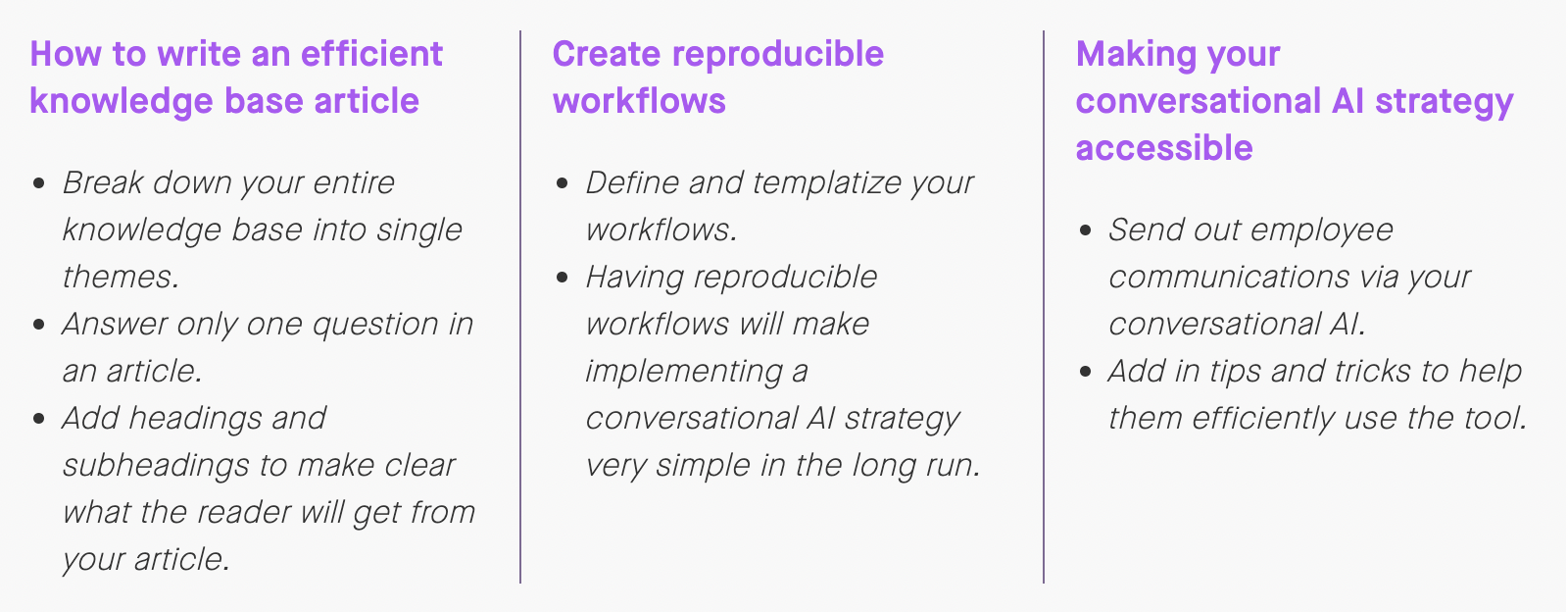5 steps to create your own conversational AI strategy
What is a conversational AI strategy?
A conversational AI strategy describes how companies implement and improve an automated process for supporting employees, using a conversational AI platform that resolves their requests.
Conversational AI has become a necessity in the workplace. AI platforms can resolve thousands of IT support issues, HR service requests, and policy questions at the speed employees expect while freeing up support teams to focus on high-impact projects.
Despite the importance of these platforms, there aren’t many resources about how to create an overall strategy for supporting employees with conversational AI, from increasing user adoption to addressing knowledge gaps. The leaders who succeed with AI develop a strategy that guides their technology decisions — not vice versa.
1. Prioritize employee experience when evaluating conversational AI
There are many factors worth considering to find the right AI platform for your business, including integrations, implementation time, analytics, and more. However, we recommend ranking employee experience as your top priority. If employees have a frustrating interaction with your conversational AI platform, they’ll never use it again — no matter its capabilities.
So what causes these frustrating interactions? Typically, they’re the product of the “do-it-yourself” approach to AI, where support teams build their own hard-coded dialog flows to address common requests and questions. The problem is that conversation can’t be hard-coded: companies evolve, resources become out-of-date, and users change topics without warning. As a result, it’s critical to work backward from an AI platform that engages with employees in unscripted conversations, rather than trying to solve a few specific use cases.
Here’s how Slack improved employee experience with conversational AI
2. Optimize your knowledge base for bite-sized solutions
Once you’ve deployed a conversational AI system that understands employees, you need to create self-service resources to resolve their issues. And because nearly 30% of these issues are knowledge-seeking questions, according to our internal data, the best place to start is optimizing your knowledge base for conversational AI.
When done correctly, every policy document, FAQ sheet, and troubleshooting guide is an opportunity to solve thousands of support issues — by surfacing the right snippet of text with AI. That means ensuring that each knowledge article covers only a single topic, is clearly organized into discrete sections, and is written with non-technical language.
When employees go searching for answers, the last thing they want to do is spend 20 minutes reading an article for the one sentence they need. A well-organized knowledge base allows your conversational AI platform to find that sentence automatically.
Read how Broadcom automated 55% of IT issues by optimizing its knowledge base

3. Create automated workflows for common support issues
Beyond answering questions, an advanced conversational AI strategy allows companies to automate workflows and accelerate approvals. First, take the time to define how your team resolves common issues, such as provisioning software licenses and approving hardware orders. Which applications are involved? How do you enforce user permissions? And who needs to sign off?
By clearly documenting the entire process, you can often reduce or eliminate the need for agent intervention, even for high-touch issues. And for requests that do require an expert to solve, conversational AI can accelerate the process by routing the request to the appropriate team.
4. Create a data-driven process for improving coverage
An effective conversational AI strategy is evolving — not static. Its foundation is data, which reveals the most frequent requests and questions from employees, the most valuable knowledge articles and forms, and the most impactful use cases for additional automation.
That’s why it’s crucial to have total visibility over your conversational AI platform, so you can not only understand but also anticipate what employees need. With this data in hand, you can build a positive feedback loop — where each issue submitted to the platform helps your team improve its future performance.
Drive employee adoption with proactive communication
Of course, all of this is for naught if your employees don’t use the conversational AI tool you’ve worked so hard to integrate. To drive employee engagement, make this tool the easiest possible thing to use. Have a clear employee adoption strategy, with every avenue of support integrated with your conversational AI system.
A great conversational AI strategy will keep the end-user in mind. It will help you to communicate with your employees with ease, without your messages getting ignored. Most importantly, implementing a conversational AI strategy should free your agents from busywork, and enable them to focus on deeper, more meaningful work.
Implementing a conversational AI strategy is the future of employee experience. Every employee, regardless of location, language, or role, deserves the same level of support — and we hope this strategy overview helps you get there.